Psoriasis, or psoriasis, is a chronic autoimmune disease that affects the skin and presents as red, patchy patches covered with small scales. The disease cannot be cured, so treatments for psoriasis are reduced to control symptoms, end swelling and pain, and provide early and lasting remission. There are many stereotypes about this disease in society. People who do not know psoriasis believe that it is possible to have the disease. In the description several types of these non-communicable diseases can be distinguished, each with its own symptoms and course.
Where does psoriasis come from?
The cause of psoriasis remains unknown, as little is known about this skin disease. Symptoms of the disease in the early stages can resemble dermatitis, eczema, but the obvious psoriasis patches cannot be confused with other skin diseases. Scientists and doctors agree that one of the factors that causes psoriasis to appear is genetic factors.
For example, if the mother is diagnosed with a skin condition, there is a 15% chance that the child will inherit the condition. If both parents were treated for psoriasis, the genetic risk of the disease quadrupled, i. e. increased to 60%.
But even if a parent carries the gene that causes skin disease, that doesn't mean the child will get the disease. The causes of psoriasis on the body are different. Stress, nervous shocks, mental trauma "trigger" skin diseases.
Psoriasis is also caused by:
- skin wounds, burns, insect bites, tattoos;
- medication the person is taking;
- Infectious Diseases;
- abuse alcohol, smoke;
- exposure to chemicals, such as detergents;
- inflammatory and fungal diseases;
- HIV;
- pregnancy and childbirth.
Recently, scientists have stated that psoriasis can be caused by malnutrition, but convincing evidence to support this theory has yet to be found.
Doctors know that a certain gene is responsible for skin disease, but they cannot determine the exact cause of psoriasis.
What does psoriasis look like in its early stages?
The first symptoms of psoriasis look like the following:
- A person's fingernails are scaly and the skin is cracked.
- Pustules appear on the body.
- The skin begins to peel off and die.
- There are blisters on the hands and soles of the feet.
- On the elbows, knees, and face, itchy red, scaly white spots appear.
A person sinks into depression, doesn't care about anything, notes a slump and even low self-esteem.
On the head, face and under the hair
First, a person notices more flaking, dandruff-like skin. Then the patches appear on their own, covered with silvery scales. A rash develops, affecting an increasing area of the skin, but even with pronounced psoriasis, the hair does not fall out.

In 80% of cases, psoriasis primarily affects the scalp. If the pathology is not treated, the rash will appear elsewhere.
A sign of a disease affecting the skin on the face is severe itching. At first, psoriasis is like an allergic disease, the skin becomes covered with small red nodules that increase in size and merge to form an inflammatory nod or papule.
The eruption covered the entire face. The pimples themselves are covered with scabs, which can be easily and painlessly separated. Beneath them is a bright red glossy skin-like terminal membrane. If you brush the itchy spots, they get small drops of blood.
On hands and feet
Psoriatic skin disease that affects the skin:
- upper arms and legs;
- drawing pen;
- knuckles and feet;
- near the nail.
It begins with the appearance of small red, circular areas on the skin between the fingers, on the shins, wrists, elbows, and knees.
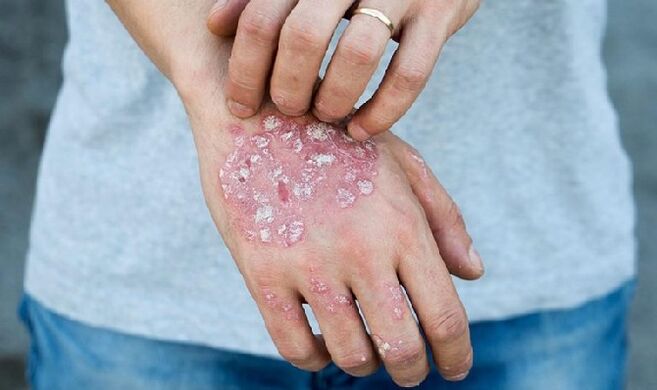
In 10% of cases, psoriasis affects the nails. Psoriasis patches appear on the nail plates long before the onset of the main symptoms of the disease affecting the body's skin.
On palms and feet
Palmar-plantar is known as a manifestation of psoriasis, affecting the skin of the palms and feet.

It is characterized by the appearance of red scaly spots covered with white scales. At the site of the rash, the skin thickens, cracks, and becomes inflamed. More severe forms are expressed in the formation of pustules, deep abscesses.
On the body
Symptoms of the disease affect the skin of the body similar to psoriasis on the palms and soles, head, and face. The rash usually appears on the back and lower back.
Red spots covered with gray-white scales cause itching. They cannot be combed, because the thin end film does not protect the smallest capillaries, and the surface of the skin, when combed, is covered with microscopic drops of blood. Psoriasis can appear on the chest and sides.
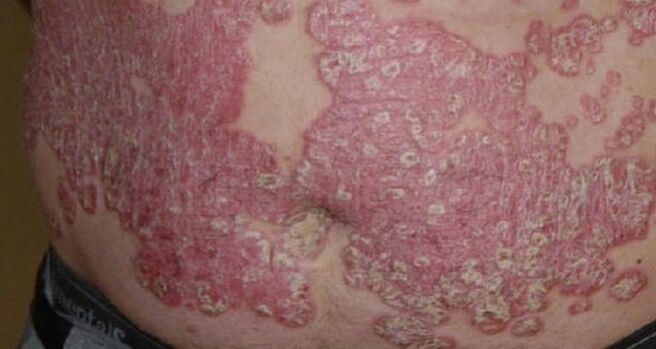
The red spots expand and merge into formations that doctors call "paraffin lakes".
Psoriasis causes many changes in the skin:
- peel off;
- thicken;
- edema;
- the appearance of vesicles-pustules.
Usually, dry, keratosis skin cracks, causing pain and discomfort.
Other localization
Systemic psoriasis spreads if the disease is raging. Psoriasis patches may be localized to the groin, buttocks, elbow folds, and knees. The disease is extremely uncomfortable, because the rashes itch but do not scratch. Careless action can easily injure the affected thin skin and cause further infection.
The symptoms of skin psoriasis are the same regardless of location, so dermatologists diagnose the disease by:
- red rash with a clear border;
- the so-called psoriatic triad: the phenomenon of "stearin stain", i. e. the plaque itself, covered with silvery soft scales, the presence of a terminal membrane under them, and small drops of blood covering the stain ifshaved;
- the appearance of new patches at the site of skin trauma;
- itchy.
Psoriatic arthritis
This form of complication affects the joints, tendons, loss of density and elasticity.
Arthritis is accompanied by symptoms of psoriasis, which is characterized by inflammation of the joints and is divided into:
- Asymmetric, affects several joints on one side of the body and does not affect paired bony elements.
- Symmetrical, like rheumatism. The joints are affected. This form often leads to disability.
- The distal joints between the vertebrae, affecting the phalanges of the fingers and toes.
- Spine, in one or more parts.
- Deformed when joints are destroyed.
Arthritis is characterized by intense pain and swelling, and the skin at the damaged joint is bluish in color. In this case, a person experiences a breakdown, sometimes the lymph nodes increase.
Classification of psoriasis
The types of psoriasis vary according to the nature of the rash. The international classification describes 10 forms of chronic autoimmune diseases:
- The most common is plaque psoriasis, or simple. It affects any part of the body, occurring in women and men. It begins with the appearance of red bumps, which are then covered with a white, flaky scab, "plaque".
- After a streptococcal infection, guttate psoriasis can affect the skin. It manifests in the thighs, shins, and also affects the neck and back. A red, bluish, lilac rash that rises to the surface of the skin and has a teardrop-like appearance.
- The mottled form is characterized by a widespread rash all over the body. The disease is more common in women than men.
- Pustules, the most severe, can be distinguished by the appearance of vesicles - pustules surrounded by red, inflamed skin and filled with clear fluid. If the infection gets into the blisters, pieces of pus will appear on the inside.
- Cystic, affecting the skin of the legs and thighs, in the form of small white papules.
- Psoriasis of the flexor surfaces, affecting the skin in the folds, for example, in the folds of the knees, groin, under the breasts, armpits.
- Palmar-plantar, often occurs in manual workers.
- Skin psoriasis affects only fingernails and toenails. The nail patches change color, become yellow, scaly, and sometimes die. The skin around the nail thickens.
- Scalp, which is characterized by a red scaly rash in the area of hair growth and itching.
- Sebum secretion, most often localized in the chest, behind the ears, between the shoulder blades, in the nasolabial folds. Psoriasis nodules are very flaky, often like eczema, covered with pus-filled crusts.
- Symptoms of erythrodermic psoriasis are pronounced. The affected skin may peel off in patches, the patient experiences severe pain, and the body temperature rises. Untreated red blood cells lead to pyoderma - a pus-filled lesion on the skin that can lead to death.
Any form of psoriasis requires prompt treatment, which can only be prescribed by a dermatologist after the necessary examination and research.
How does psoriasis manifest in different stages?
In total, 4 stages of the development of psoriasis are distinguished:
- initially, or soon;
- progressive;
- freeze;
- recession.
In most cases, psoriasis begins with the appearance of small papules. Round, glossy pink spots, sometimes no more than the tip of a pin, raised above the skin and clearly outlined. They are covered with silver scales. The presence of a skin rash in the early stages of psoriasis can be confused with eczema or an allergic rash.

The clinical picture of the disease at different stages is very different. For example, severe dermatitis is characteristic of an acute or progressive form requiring intensive medical attention and treatment.
However, the rashes do not go away, but increase and merge together. Psoriasis patches, clearly delimited by a pink corolla, begin to peel. The affected area of the skin is itchy and uncomfortable.
It takes 2 weeks to a few months and psoriasis turns into a sedentary phase. The growth of psoriatic plaques stops, the flaking increases, covering the entire affected area.
With regressive psoriasis, the flaking gradually disappears, the patches of psoriasis flake off and gradually disappear. There are no marks, scars or scars on the skin. Sometimes there is hyperpigmentation of the skin. In the remission stage, the skin has a normal color and texture.
What is the danger of the disease?
The severity of the course of the disease depends on the condition of the skin. If the lesions do not spread, the patient leads a normal life. People experience physical and psychological discomfort when the rash covers a large area, the skin becomes inflamed. A significant health hazard is complications of pustular psoriasis if an infection has penetrated the blisters.
Psoriatic arthritis is also dangerous because some forms of it destroy joints and lead to disability. However, inflammation of the joints develops quite rarely, in 10% of cases.
Even if the patches on the skin are insignificant and the person feels fine, it is important to see a dermatologist to make a diagnosis and start treatment. Timely access to a doctor will prevent complications and help keep the disease in stable remission.
Complex treatment of psoriasis
There is no effective way to get rid of psoriasis forever. Skin diseases are treated by various means. A person is prescribed pills, ointments, and physical therapy is prescribed. It is recommended to take a bath for healing and to carefully take care of the condition of the skin, to avoid injuries, such as scratches, cuts, abrasions.
Holistic treatment of psoriasis works if a person adheres to medical prescriptions.
How to treat psoriasis with medicine?
This is an ointment, pill, or injection that the attending physician prescribes to the person who has asked for help. Tablets are taken at the indicated times of the day before or after meals, ointments are applied to the affected areas with clean hands, injections can be done at home or in the hospital. These can be products based on plant ingredients, hormones and other chemically active substances.
In the complex therapy of using scaly lichen:
- Antihistamines, prescribed if a person has allergies.
- Hepatoprotective drugs support the liver.
- Immunomodulatory drugs facilitate the course of the disease.
- Immunosuppressive drugs in the form of injections. They are effective, but expensive and have serious side effects. The drug is not used for people with infections or cancer.
- Gluosteroids are effective, but addictive. Therefore, the treatment with hormonal drugs lasts no more than 2 weeks.
If lichen scabs easily, your doctor will try to limit the use of topical medications.
Topical drugs - ointments, sprays
Topical psoriasis remedies are divided into:
- Hormones affect the body's autoimmune processes.
- Therapy, including zinc, naftalan, tar, vitamins. They moisturize chapped skin, soften hard psoriatic lesions, support skin function, and repair damaged crust.
Hormonal ointments, lotions, and skin sprays are used during exacerbations. Bioactive substances in the composition of strong creams:
- relieve itching;
- reduce puffiness;
- spasm of blood vessels;
- pain relief and anti-inflammatory.
Apply the product to the acne-affected areas of the body, face and parts of the head. Medical ointments are most often used after the acute phase of psoriasis has passed, and doctors do not recommend using hormonal preparations and creams with vitamin D for more than 2 weeks.
Medicines and injections
A person interested in psoriasis treatment can ask a dermatologist about effective pills and injections used in complex therapy of psoriasis.
- Certain medications are prescribed if psoriasis is severe. For example, the pills that a person receives if damaged skin does not heal.
- The doctor prescribes B vitamins, folic acid, omega acids, other multivitamins, and lecithin. These drugs are restorative, non-addictive, shorten treatment time and prolong remission.
Complex therapy of scaly lichen is not limited to the ingestion of special substances and vitamins.
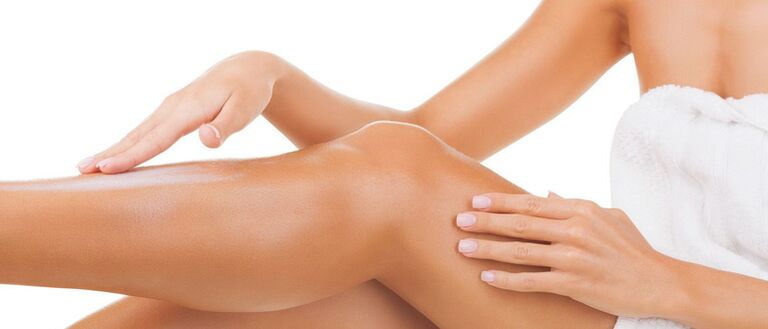
If a person adheres to the rules, uses high-quality cosmetics, maintains the health and condition of the skin, psoriasis is practically not terrible for him.
If there are no contraindications, a person can inject drugs containing immunosuppressants:
- Some drugs are injected under the skin, while others used to treat psoriatic arthritis are given intravenously.
- Injections have serious contraindications. People under 18 years of age, pregnant and breastfeeding should not use them in the presence of malignant tumors and infectious diseases.
Homeopathy
Homeopathic medicine manufacturers claim that the use of these drugs reduces the risk of relapse and ensures a quick recovery from the problem. In addition, the fund:
- Supports immunity and health of internal organs.
- They are a source of essential minerals and vitamins for the body.
- Restores the work of the intestines, sows in the digestive tract beneficial bacteria.
- Helps eliminate toxins.
When choosing a drug, homeopathy takes into account the person's history, stage and nature of the disease process, heredity and psychiatric factors.
Formal medicine has no evidence of the effectiveness of homeopathic remedies in the treatment of psoriasis.
Physiotherapy in the fight against skin diseases
Usually, the affected skin is irradiated with light waves of the ultraviolet spectrum of different lengths or with a laser. Sometimes before a procedure, a person takes psoralens, which increase the sensitivity of skin cells to radiation. The doctor also prescribes cryotherapy, when the damaged skin is exposed to low temperatures. More recently, ultraviolet blood irradiation has been used to combat psoriasis.
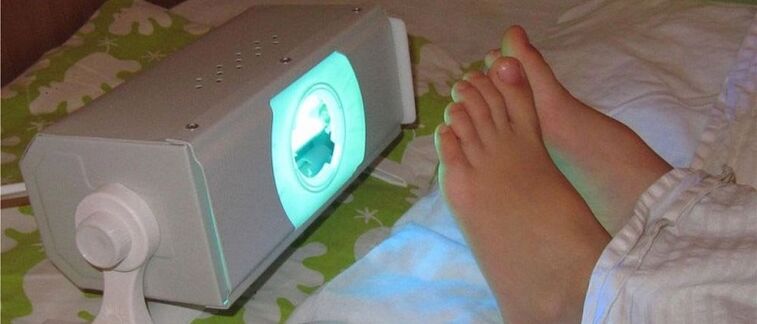
Ultraviolet irradiation is one of the simplest physiotherapeutic treatments. At the same time, the effectiveness of this method shows quite confidently.
The duration of the sessions varies, but physical therapy is quite effective. This is one of the ways to help you quickly cure psoriasis. The procedure returns the activity to a person, allowing him to fully live and work.
Can folk cure psoriasis be cured forever?
Scaly lichen cannot be treated. Tablets, ointments, injections fight the symptoms of the disease, reducing the number of relapses. Folk remedies are no exception. Decoction, decoction, healing bath water contribute to the remission of the disease but do not reduce the autoimmune disease.
Drug
Means based on medicinal herbs and plants help to stop the symptoms of psoriasis. The safest are chamomile decoctions, fresh aloe vera juice, compresses and decoctions of burdock rhizomes and leaves.
In pharmacies, you can buy herbal preparations against scaly lichen. They can be mixed with boiling water, infused, and taken before or after meals, or you can pour into water and take a therapeutic bath.
According to traditional medicine, the use of hydrogen peroxide eliminates the manifestations of psoriasis. Drug use:
- As a solution. First, dilute one drop of the product in 3 tablespoons of water and drink it on an empty stomach half an hour before a meal. Gradually increase the concentration of the solution to 10 drops for the same amount of water. Take the medicine once every three days.
- Externally, gauze is applied to the affected skin for an hour, moistening the sterile gauze in a solution of 2 teaspoons of peroxide and 50 ml of water.
Before using any folk remedies, consult your doctor.
Compressor and bath
Compresses and baths with decoction of medicinal plants will not cure the disease, but they will relieve the general condition, soothe itching and inflammation. Manufactured for external use:
- Chrysanthemum;
- succession;
- musk;
- burdock root;
- oak bark;
- hop;
- sage and others.
Do not shower for longer than 20 minutes.
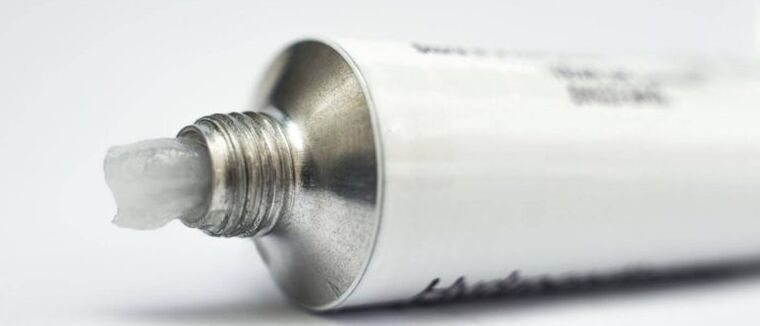
After bathing, moisturizers and therapeutic ointments are applied to the skin.
Bathing and applying with herbal decoction practically has no contraindications.
Skin care and protection
There is no complete cure for psoriasis. But all the time of treatment and during remission, a person must take proper care of the skin:
- Avoid traumatic effects on the skin. No scratches, no scratches. During physical work or cleaning, use protective equipment.
- Wear comfortable clothes made of natural materials.
- Use special dermatological cosmetics.
- Moisturize the skin.
- Avoid exposure to direct sunlight.
Preventive measures also include changes to the diet and lifestyle that the person makes.
Lifestyle changes and nutrition
Food is not the cause of psoriasis, however, malnutrition will weaken the body's defenses, reducing resistance to stressors. Therefore, a person with scaly lichen needs to monitor nutrition and daily activities.
When asked about how to treat psoriasis, your doctor will list precautions:
- Refuse greasy, fried foods.
- Active lifestyle, moderate physical activity.
- It is recommended to sunbathe in the evening and in the morning.
- Quit smoking and alcoholic beverages.
A person should prioritize healthy meals with a high content of nutrients, vitamins and minerals.
What to do if a child is sick
The first thing parents do when they notice signs of scaly lichen on their children's skin is to seek help from a doctor. Treating the disease in its early stages can reduce the intensity of the rash that causes physical and emotional pain in children.
It is necessary to teach children to take care of their skin properly and adhere to a healthy lifestyle. Socialization is very important for children, so parents should encourage children to want to sport, make friends, join circles. To deal with emotional discomfort, children may need the help of a psychotherapist, who will teach them not to react to possible silly comments from friends and eveneven narrow-minded adults.
Can psoriasis be completely cured?
A person is faced with an itchy, scaly rash on the skin, bringing with it physical and psychological inconvenience, they must seek treatment for this disease or not.
All about psoriasis and its treatment can be learned from the dermatologist you have asked for help. There are associations and support centers where you can also get essential information, including legal information, such as what benefits will be enjoyed if a person is diagnosed with psoriasis.
It is not possible to completely cure psoriasis, because the disease is related to genetic factors and genes cannot be treated with drugs, procedures, homeopathy and folk remedies.
Modern drugs, ointments, procedures are really effective against the symptoms of the disease, prolonging the period of remission. But, regardless of the methods used, psoriasis can return. The disease recurs more often if the patient neglects the medical examination, does not follow the simple rules of prevention.
Is this disease preventable?
The "three pillars" for the prevention of skin diseases are based on:
- Observe the rules of personal hygiene.
- Reasonable diet.
- Reject bad habits.
For washing, it is better to use only cosmetic dermatological products purchased at the pharmacy. Well, if they contain tar.























